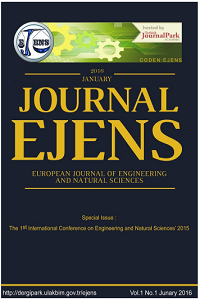Comparison of Performance of Conventional Membrane Bioreactor with Dynamic Membrane Bioreactor
Comparison of Performance of Conventional Membrane Bioreactor with Dynamic Membrane Bioreactor
Dynamic membrane, membrane bioreactors, non-woven 0.45 µm membrane,
___
- [1]. S. Judd, The MBR book. Oxford, Elsevier, 2006.
- [2]. G.T.Seo, B.H. Moon,T.S. Lee,T.J. Lim, I.S. Kim, Non-woven fabric filter separation activated sludge reactor for domestic wastewater reclamation. Wat. Sci. Tech., 47(1), 133–138, 2002.
- [3]. H. D. Park, I. S. Chang, K. J. Lee, Principles of Membrane Bioreactors for Wastewater Treatment, CRC Press, Taylor&Francis Group, 2015.
- [4]. W.Fuchs, C.Resch, M.Kernstock, M. Mayer, P.Scoeberl, R. Braun,Influence of operational conditions on the performance of a mesh filter activated sludge process. Water Res. 39 (4), 803–810, 2005.
- [5]. Y. Kiso, Y.J. Jung, K.S. Min, W. Wang, M. Simase, T. Yamada. Coupling of sequencing batch reactor and mesh filtration: operational parameters and wastewater treatment performance. Water Res. 39, 4887–4898, 2005.
- [6]. M.H.Al-Malack and G.K. Anderson, Formation of dynamic membranes with crossflow microfiltration. J. Membr. Sci. 112, 287–296, 1996.
- [7]. M. Ye, H. Zhang, Q. Wei, H. Lei, F. Yang, X. Zhang, Study on the suitable thickness of a pac–pre-coated dynamic membrane coupled with a bioreactor for municipal wastewater treatment. Desalination 194, 108–120, 2006
- [8]. C. Wisniewskand A. Grasmick,Coll Surf A: PhysicochemEng Aspects 138:403, 1998.
- [9]. P.Côté, D. Thompson, Water SciTechnol 41:209, 2000.
- [10]. Y. Wu, X. Huang, X. Wen, F. Chen, Function of dynamic membrane in selfforming dynamic membrane coupled bioreactor. Water Sci. Technol. 51 (6–7), 107–114, 2005.
- [11]. L. Chu andS. Li, Filtration capability and operational characteristics of dynamic membrane bioreactor for municipal wastewater treatment. Sep. Purif. Technol. 51, 173–179, 2006.
- [12]. F. Li, J. Chen, C. Deng, The kinetics of crossflow dynamic membrane bioreactor. Water SA 32 (2), 199–203, 2006.
- [13]. H.Q. Chu, D. Cao, W. Jin, B.Z. Dong, Characteristics of bio-diatomite dynamic membrane process for municipal wastewater treatment. J. Membr. Sci. 325, 271–276, 2008.
- [14]. D.W. Cao, H.Q. Chu, W. Jin, B.Z Dong, Characteristics of the biodiatomite dynamic membrane (cake layer) for municipal wastewater treatment. Desalination 250, 544–547, 2010.
- [15]. D. Jeison, I. Diaz, J.B. van Lier, Anaerobic membrane bioreactors: are membranes really necessary? Electron. J. Biotech. 11 (4), 1–7, 2008.
- [16]. A.E. Marcinkowsky, K.A. Kraus, H.O. Phillips, J.S. Johnson, A.J.Shor, Hyperfiltration studies IV. Salt rejection by dynamically formed hydrous oxide membranes. J. Am. Chem. Soc. 88 (24), 5744–5750, 1966.
- [17]. D. Freilich, G.B. Tanny, The formation mechanism of dynamic hydrous Zr(IV) oxide membrane on microporous supports. J. Colloid Int. Sci. 64, 362–370, 1978.
- [18]. T. Ohtani, M. Nakajima, Y.Nawa, A. Watanabe, Formation of dynamic UF membrane with fine Zr particles. J. Membr. Sci. 64, 273–281, 1991.
- [19]. M. Rumyantsev, A.Shauly, S.Yiantsios, D.Hasson, A.Karabelas, R.Semiat, Parameters affecting the properties of dynamic membranes formed by Zr hydroxide colloids. Desalination 131, 189–200, 2000.
- [20]. M. Altman, R. Semiat, D. Hasson, Removal of organicfoulantsfromfeedwatersbydynamicmembranes. Desalination 125, 65–75, 1999.
- [21]. R.Y.Horng, C. Huang, M.C. Chang, H. Shao, B.L.Shiau, Y.J. Hu, Application of TiO2 photocatalytic oxidation and non-woven membrane filtration hybrid system for degradation of 4-chlorophenol. Desalination 245, 619-182, 2009.
- [22]. Y. Zhao, Y. Tan, F.S. Wong, A.G. Fane, N. Xu, Formation of Mg(OH)2 dynamic membranes for oily water separation: effects of operating conditions. Desalination 191, 344–350, 2006.
- [23]. J. Y. Lee, S. K. Maeng, B. K. Choi, K. H. Ahn, K. G. So, Characteristics of flux and gel layer on microfilter and non-woven fabric filter surface based on anoxic–aerobic MBRs, Bioprocess Biosyst Eng, 35:1389–1398, 2012.
- [24]. L. Chu and S. Li, Filtration capability and operational characteristics of dynamic membrane bioreactor for municipal wastewater treatment, Separation and Purification Technology, 51, 173–179, 2006.
- [25]. X. H. Zhou, H. C. Shi, Q. Cai, M. He, Y. X. Wu, Function of selfforming dynamic membrane and biokinetic parameters determination by microelectrode, Water Res 42:2369–2376, 2008.
- Başlangıç: 2015
- Yayıncı: CNR Çevre
Diagnosis of Coronary Artery Disease Using Deep Belief Networks
PSIM Simulation of Flyback Converter for P&O and IC MPPT Algorithms
Process Design for the Recycling Of Tetra Pak Components
Biodiesel Production Using Wet and Dry Purification Methods
Determination of Priority Contamination Factors in Lake of Manyas (Bird Paradise)
